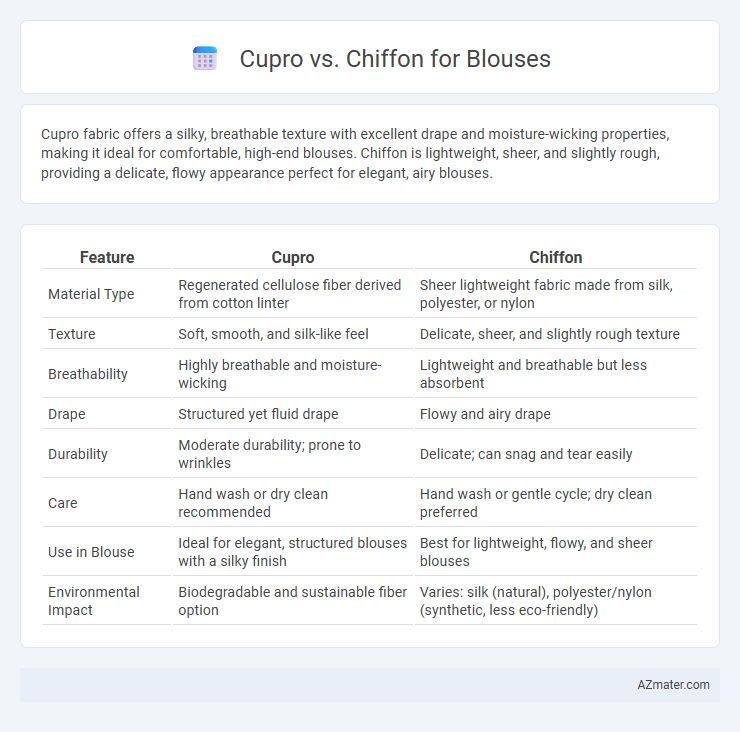Cupro fabric offers a silky, breathable texture with excellent drape and moisture-wicking properties, making it ideal for comfortable, high-end blouses. Chiffon is lightweight, sheer, and slightly rough, providing a delicate, flowy appearance perfect for elegant, airy blouses.
Table of Comparison
| Feature | Cupro | Chiffon |
|---|---|---|
| Material Type | Regenerated cellulose fiber derived from cotton linter | Sheer lightweight fabric made from silk, polyester, or nylon |
| Texture | Soft, smooth, and silk-like feel | Delicate, sheer, and slightly rough texture |
| Breathability | Highly breathable and moisture-wicking | Lightweight and breathable but less absorbent |
| Drape | Structured yet fluid drape | Flowy and airy drape |
| Durability | Moderate durability; prone to wrinkles | Delicate; can snag and tear easily |
| Care | Hand wash or dry clean recommended | Hand wash or gentle cycle; dry clean preferred |
| Use in Blouse | Ideal for elegant, structured blouses with a silky finish | Best for lightweight, flowy, and sheer blouses |
| Environmental Impact | Biodegradable and sustainable fiber option | Varies: silk (natural), polyester/nylon (synthetic, less eco-friendly) |
Introduction to Cupro and Chiffon Fabrics
Cupro fabric, derived from regenerated cellulose fibers extracted from cotton linter, offers a silky texture and excellent breathability ideal for blouses. Chiffon, a lightweight, sheer fabric made from silk or synthetic fibers, provides a flowy and delicate appearance perfect for elegant or layered blouse designs. Both materials differ significantly in drape, moisture wicking, and feel, catering to various style and comfort preferences.
Key Differences Between Cupro and Chiffon
Cupro is a regenerated cellulose fiber made from cotton linter, known for its silky smooth texture, breathability, and durability, making it ideal for structured blouses that drape well. Chiffon, a lightweight, sheer fabric typically made from silk or polyester, offers a soft, flowing appearance with a slightly textured surface, providing an airy and delicate look perfect for layered or ruffled blouse designs. Key differences include cupro's matte finish and excellent moisture absorption compared to chiffon's sheer transparency and light weight, influencing the blouse's style, comfort, and care requirements.
Texture and Feel: Cupro vs Chiffon
Cupro offers a silky smooth texture with a soft, breathable feel that mimics natural fibers, providing a matte finish and luxurious drape ideal for comfortable blouses. Chiffon, made from lightweight sheer fabric, delivers a slightly rougher texture with a delicate, flowy quality that creates an airy and elegant silhouette. While Cupro feels cooler and more substantial against the skin, chiffon emphasizes lightness and transparency, making each fabric suited for different blouse styling and tactile preferences.
Breathability and Comfort Comparison
Cupro fabric offers superior breathability due to its natural cellulose fibers derived from cotton linter, allowing excellent moisture absorption and air circulation for enhanced comfort in warm weather. Chiffon, typically made from silk or synthetic fibers, has a lightweight and sheer texture but tends to retain heat and is less breathable, which may cause discomfort in hot or humid conditions. For blouses, choosing cupro ensures a cooler, softer feel against the skin, making it ideal for prolonged wear in warmer climates compared to chiffon's delicate yet less breathable nature.
Durability and Maintenance of Cupro and Chiffon
Cupro offers superior durability compared to chiffon, maintaining its structure and resistance to wear over time due to its regenerated cellulose fibers. While chiffon is delicate and prone to snagging or tearing, requiring gentle hand washing or dry cleaning, cupro is more versatile in maintenance, often machine washable on a gentle cycle and less susceptible to damage. The breathable, silky texture of cupro combines ease of care with long-lasting wear, making it a practical choice for blouse fabrics where durability and low maintenance are priorities.
Sustainability and Eco-Friendliness
Cupro fabric, derived from cotton cellulose, is biodegradable and often produced using closed-loop processes that recycle chemicals, making it a more sustainable choice compared to traditional synthetic fabrics. Chiffon, typically made from polyester or nylon, relies on non-renewable petroleum resources and involves energy-intensive manufacturing that contributes to microplastic pollution. Selecting Cupro for blouses supports eco-friendly fashion with reduced environmental impact and better biodegradability, while chiffon poses greater sustainability challenges due to its synthetic origins.
Cupro vs Chiffon: Style and Appearance
Cupro exhibits a smooth, silky texture with a subtle sheen that enhances the drape and elegance of blouses, making it ideal for a polished, sophisticated look. Chiffon is lightweight, sheer, and flowy, offering a delicate, ethereal appearance that adds softness and movement to blouse designs. The choice between Cupro and Chiffon impacts style significantly, with Cupro providing structure and richness, while Chiffon lends a light, airy aesthetic.
Suitability for Blouse Designs
Cupro excels in blouse designs due to its silky texture, breathability, and ability to drape smoothly, making it ideal for structured and flowy silhouettes. Chiffon offers a lightweight, sheer quality that enhances femininity and layering but requires lining for modesty and is better suited for delicate, loose-fitting blouses. Both fabrics provide versatility, but Cupro's durability and sheen favor tailored designs, whereas Chiffon highlights ethereal, airy aesthetics.
Price Comparison: Cupro vs Chiffon
Cupro blouses typically range from $40 to $90, offering a mid-range price point due to their sustainable production and silk-like texture. Chiffon blouses vary broadly, with prices from $20 to $100, influenced by fabric quality and brand prestige. When comparing cost-effectiveness, cupro provides durability and eco-conscious value, while chiffon offers more budget-friendly options but may lack long-term resilience.
Final Verdict: Which is Better for Blouses?
Cupro offers a silky smooth texture with excellent breathability and durability, making it ideal for high-quality, polished blouses that maintain shape and comfort. Chiffon provides a lightweight, sheer appearance with graceful drapes, perfect for romantic, flowy blouses but requires delicate care and is less durable. For long-lasting, versatile blouses, Cupro is better, while Chiffon excels in style-focused, airy designs.

Infographic: Cupro vs Chiffon for Blouse
 azmater.com
azmater.com